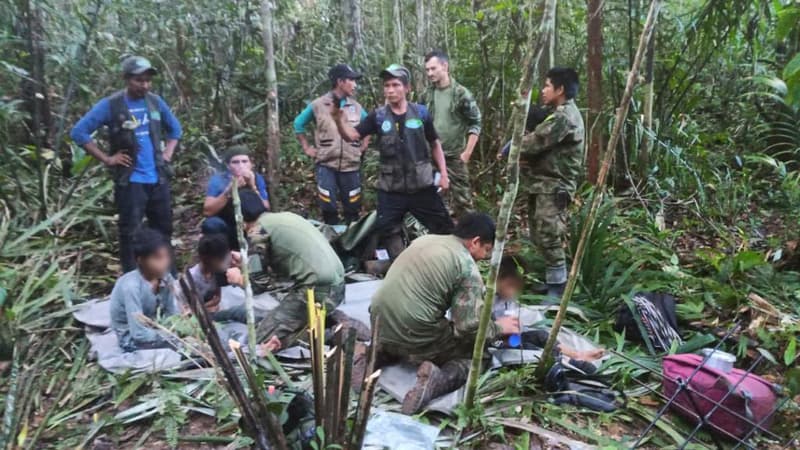“There are no words that can represent this feat there.” Lesly, Soleiny, Tien Noriel and Cristin were found alive on Friday June 9 by rescuers, after wandering alone for 40 days in the Colombian Amazon jungle.
“They were dehydrated (…) But in general their condition is acceptable. They are out of danger”, even greeted the Minister of Defense, Iván Velásquez.
The four children, from 1 to 13 years old, had been wanted since the May 1 crash of the Cessna 206 plane in which they were traveling with their mother, the pilot and a relative. All three adults died in the accident. 40 days alone, without an adult, in the middle of the jungle and in “acceptable” conditions. Why miracle?
Just “some skin lesions and bites”
“It’s even more of a miracle,” says Damien Lecouvey. Survival specialist and consultant for several television programs, he confessed this Saturday night to BFMTV that he “had never heard stories like that.”
William Wadoux, consultant for development projects and co-organizer of survival courses in the Amazon, also underlines on BFMTV the specificity of the place, “mountainous” and with 80% humidity”.
“Imagine the ordeal: you lose three adults in the plane crash. You are in one of the most difficult biotopes on the planet with extreme climatic limitations: high temperatures and significant water needs”, Damien Lecouvey detailed on our antenna.
For him, the first danger remains above all “the risk of heat stroke related to dehydration”, in particular for very young children under one year of age. “The more days go by, the more survivability decreases. 40 days is huge.”
Except that, apart from “some skin lesions and bites”, the children do not present “any pathology or degraded state of health,” said a military doctor. “They are stable, tests are being carried out” and a renutrition protocol is applied to them, with psychological support.
Children of an indigenous group
Does it have anything to do with the community to which the children belong? Coming from the Uitoto indigenous group, the children are used to life in the jungle and know how to survive there, according to their relatives.
“This is one of the ethnic groups found in the western part of the Amazon,” says William Wadoux on BFMTV, “parents always go looking for things in the forest with their children. Then they dive into these things and they taste good. how to identify which fruits to eat or which plants to take for certain uses”.
“Their fears are not exactly the same as what we could have in those places,” he still believes in our antenna.
For the National Organization of Amerindian Peoples of Colombia (Opiac), “the survival of children is the demonstration of the knowledge and relationship that indigenous people have with nature, a link taught from the womb.”
All the officials praised the cooperation in the field of the commandos and the indigenous volunteers, in a country where decades of internal conflict and violence have left rather mistrust between these two actors. “Without the indigenous people, their experience and their knowledge of the jungle, this unexpected result could not have been achieved, all the soldiers recognize it,” said Minister Velásquez: “they were the guides of our commandos in the jungle.”
Its possible survival thanks to the knowledge of the greatest
During his speech, the Minister of Defense paid special tribute to the eldest of the brothers, Lesly: “It is thanks to her, her courage and her leadership, that the other three were able to survive with her care, her knowledge of the jungle” . “.
“I think that’s really what saved them all,” said Nicolas Mathieux on our channel. This adventurer and explorer believes that this happy ending “would never have happened with people who do not know a minimum of forest and jungle, it would be impossible.”
“It will be interesting to see what they consumed,” William Wadoux also asked on BFMTV.
“Children of the forest”, they “survived first by eating a little flour (which was on board the crashed plane), then seeds”, according to the grandfather of the surviving children. It remains a “mystery” for William Wadoux: little Cristin’s diet, less than a year old.
“At that age they need breast milk, it is likely that they have used an equivalent that comes from lianas,” recalls the co-organizer of survival courses in the Amazon, “without a doubt certain plants have been able to allow the child to survive and last the enough time to recover.”
Source: BFM TV


